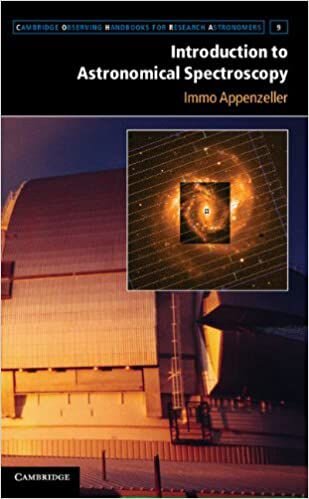

Most ebook files are in PDF format, so you can easily read them using various software such as Foxit Reader or directly on the Google Chrome browser.
Some ebook files are released by publishers in other formats such as .awz, .mobi, .epub, .fb2, etc. You may need to install specific software to read these formats on mobile/PC, such as Calibre.
Please read the tutorial at this link. https://ebooknice.com/page/post?id=faq
We offer FREE conversion to the popular formats you request; however, this may take some time. Therefore, right after payment, please email us, and we will try to provide the service as quickly as possible.
For some exceptional file formats or broken links (if any), please refrain from opening any disputes. Instead, email us first, and we will try to assist within a maximum of 6 hours.
EbookNice Team

Status:
Available0.0
0 reviews
ISBN 10: 1107015790
ISBN 13: 9781107015791
Author: Immo Appenzeller
Spectroscopy is the principal tool used in astronomy to investigate the Universe beyond Earth's atmosphere. Through the analysis of electromagnetic radiation, spectrographs enable observers to assess the chemical composition, kinematics and local physical properties of distant stars, nebulae and galaxies. Thoroughly illustrated and clearly written, this handbook offers a practical and comprehensive guide to the different spectroscopic methods used in all branches of astronomy, at all wavelengths from radio to gamma-ray and from ground and space-borne instruments. After a historical overview of the field, the central chapters navigate the various types of hardware used in spectroscopy. In-depth descriptions of modern techniques and their benefits and drawbacks help you choose the most promising observation strategy. The handbook finishes by assessing new technologies and future prospects for deep-sky observation. This text is an ideal reference for today's graduate students and active researchers, as well as those designing or operating spectroscopic instruments.
1 Historical Remarks
1.1 Early Pioneers
1.2 The Photographic Era
1.3 The Impact of Linear Detectors
1.3.1 Photon Detection
1.3.2 Photocathode Devices
1.3.3 Solid-State Array Detectors
1.4 Extending the Wavelength Range
1.4.1 The Radio SpectralWindow
1.4.2 The High-Energy Sky
1.4.3 The Last Gaps
2 Spectroscopy in Present-Day Astronomy
2.1 Spectral Classification
2.2 Radial Velocities
2.3 Gravitational and Cosmological Redshifts
2.3.1 Gravitational Redshifts
2.3.2 Cosmological Redshifts
2.4 Astrophysical Applications
2.4.1 Stars
2.4.2 Interstellar Gas and Dust
2.4.3 Accretion-Powered Sources
2.4.4 Galaxies
2.4.5 Intergalactic Space and Background Radiations
2.5 Magnetic Fields
2.6 The Importance of Spectral Resolution
3 Basic Physics of Spectral Measurements
3.1 Electromagnetic Radiation
3.1.1 Monochromatic Plane Waves
3.1.2 The General Case
3.2 Measuring Frequencies
3.3 Measuring Wavelengths
3.3.1 Wavelength Measurements Using Interference
3.3.2 Diffraction Gratings
3.3.3 Blazed Gratings
3.3.4 Volume Phase Gratings
3.3.5 Prisms
3.3.6 Grisms
3.3.7 Echelon Gratings
3.4 Accuracy Limits
3.4.1 Frequencies and Wavelengths
3.4.2 Photometric Accuracy
4 Optical-Range Grating and Prism Spectrometers
4.1 Commercially Available Spectrometers
4.2 Basic Components of Astronomical Spectrometers
4.3 Slitless Spectroscopy
4.4 Single-Object Slit Spectrometers
4.4.1 Slit Width and Spectral Resolution
4.4.2 Effects of Slit Illumination
4.4.3 Pre-Slit Optics
Image Slicers
Atmospheric Dispersion Compensators
4.4.4 The Littrow Configuration
4.4.5 Rowland Circles
4.4.6 Echelle Spectrometers
Echelle Optics
Properties of the Echelle Format
4.4.7 Echelon Spectrometers
4.5 Fiber-Coupled Instruments
4.6 Multiobject Spectrometers
4.6.1 Multislit Spectroscopy
4.6.2 Multifiber Instruments
4.7 Integral Field Spectroscopy
4.8 Cold IR Spectrometers
4.8.1 General Principles
4.8.2 Design Details
4.8.3 Ground-Based MIR Instruments
4.8.4 Space-Based and Airplane Observatories
5 Other Techniques for the Optical Spectral Range
5.1 Fabry-Perot Techniques
5.2 Fourier Transform Spectrometers
5.3 Direct Detection of Visual Photon Energies
5.3.1 Microbolometers
5.3.2 Superconducting Tunnel Junctions
6 Preparing and Reducing Optical Observations
6.1 Planning and Preparing Observing Runs
6.1.1 General Considerations
6.1.2 MOS Preparation
6.1.3 Diffraction-Limited Spectroscopy
6.1.4 Ground-Based MIR and NIR Observations
6.2 The Execution Phase
6.3 Calibration Procedures
6.3.1 Wavelength Calibration Strategies
6.3.2 Flux Standard Observations
6.4 Reduction of Raw Spectra
6.4.1 Bias Subtraction
6.4.2 Removal of Cosmics and Other Artifacts
6.4.3 Flat-Field Correction
6.4.4 Wavelength Calibration
6.4.5 Sky Subtraction
6.4.6 Extraction of One-Dimensional Spectra
6.4.7 Merging of Echelle Orders
6.4.8 Flux Calibration
6.4.9 Corrections for Atmospheric Absorption Features
6.4.10 Reference Frame Corrections
6.5 Archiving Spectral Data
7 UV, X-Ray, and Gamma Spectroscopy
7.1 UV and X-Ray Optics
7.1.1 Normal-Incidence Mirrors
7.1.2 Multilayer Mirrors
7.1.3 Grazing-Incidence Optics
7.2 UV Spectrometers
7.3 Photon-Energy Sensitive X-Ray Detectors
7.4 X-Ray Grating Spectrometers
7.5 Gamma Spectroscopy
7.5.1 Diodes and Scintillation Detectors
7.5.2 Pair-Production Detectors
8 Spectroscopy at Radio Wavelengths
8.1 Detection of Radio Waves from Space
8.2 Filter Banks
8.3 Fast Fourier-Transform Spectrometers
8.4 Autocorrelation Techniques
8.5 Cross-Correlation Spectroscopy with Arrays
8.6 Acousto-Optical Instruments
8.7 Chirp-Transform Spectrometers
9 Special Techniques of the FIR and Submillimeter Range
9.1 Spectroscopy with Bolometers
9.1.1 Basic Physics of Bolometers
9.1.2 Practical Application to Spectroscopy
9.1.3 Hot Electron Bolometers
9.2 Heterodyne Spectroscopy at FIR and Submillimeter Wavelengths
10 New Developments and Future Prospects
10.1 Scientific Drivers
10.2 New Facilities
10.2.1 TMT
10.2.2 ESO E-ELT
10.2.3 The JamesWebb Space Telescope
10.2.4 Other Large-Scale Future Facilities
10.3 New Technologies
10.3.1 MEMS-Based Multiobject Spectroscopy
10.3.2 New Detectors
10.3.3 ArrayedWaveguide Spectrometers
10.4 Organizational Challenges
astronomy introduction pdf
introduction to astronomy textbook pdf
introduction to astronomy book
an introduction to astronomy
astronomy introduction lecture
introduction to astronomy pdf
Tags: Immo Appenzeller, Astronomical, Spectroscopy